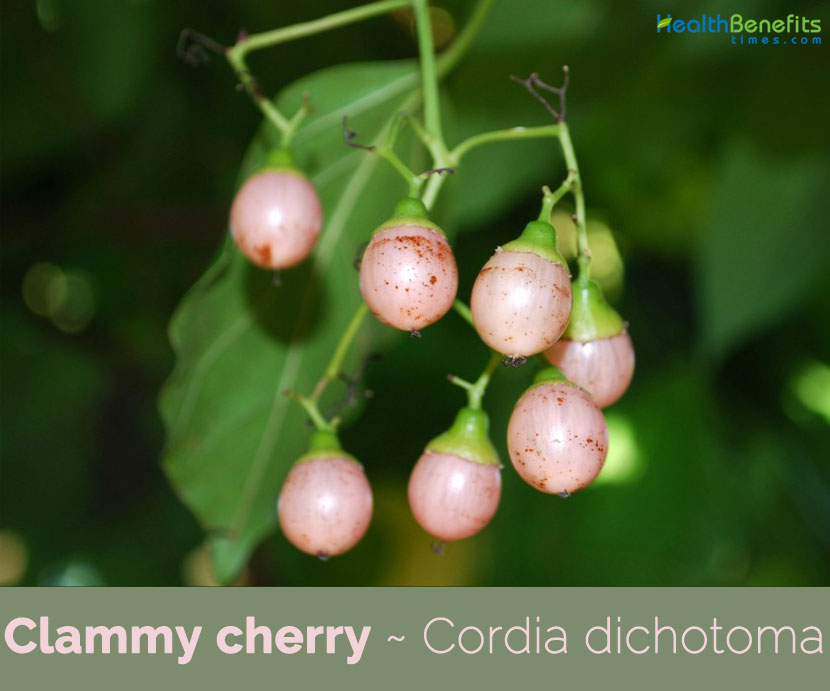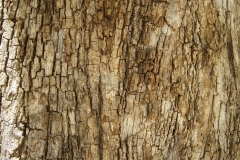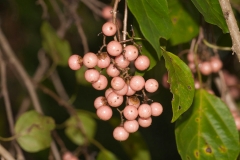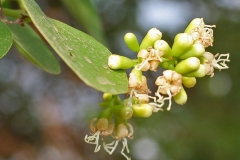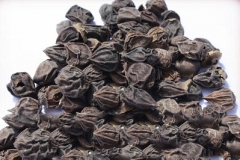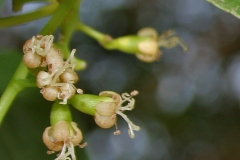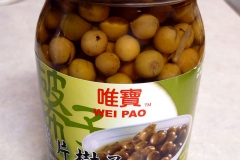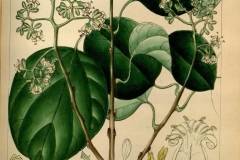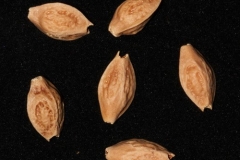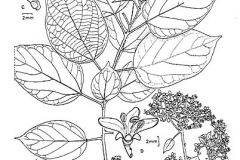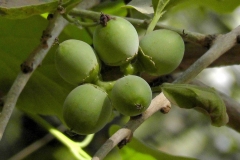| Clammy cherry Quick Facts |
| Name: |
Clammy cherry |
| Scientific Name: |
Cordia dichotoma |
| Origin |
China, the Ryukyu Islands of Japan, Taiwan, India, Pakistan, Sri Lanka, Cambodia, Laos, Burma, Philippines Thailand, Vietnam, Indonesia, Malaysia, Papua New Guinea, Australia and New Caledonia |
| Colors |
Yellow or pinkish-yellow shining which turns black on ripening |
| Shapes |
Drupes sub globose, 2 cm in diameter, with sticky mesocarp |
| Taste |
Mildly sweet |
| Health benefits |
Beneficial for dyspepsia, diarrhea, dysentery fever, headache, stomach-ache, tumors, catarrh, gonorrhea, ringworm, spider bites and eruptive boils and various urinary disorders |
Cordia dichotoma commonly known as Clammy cherry is a species of flowering tree in the borage family, Boraginaceae. The plant is native to China (Fujian, Guangdong Guangxi, Guizhou, southeast Xizang, and Yunnan) the Ryukyu Islands of Japan, Taiwan, India, Pakistan, Sri Lanka, Cambodia, Laos, Burma, Philippines Thailand, Vietnam, Indonesia, Malaysia, Papua New Guinea, Australia (Northern Territory and Queensland) and New Caledonia. Few of the popular common names of the plant include Fragrant Manjack, Bird lime tree, Clammy cherry, Cordia tree, Glueberry tree, Indian cherry, Indian glue berry, Sebesten, sebesten plum, pink pearl, snotty gobbles, snotty gobbles, cumming cordia, glue berry, anonang and Booch.
Plant description
Clammy cherry is a small to moderate sized deciduous, perennial fast-growing tree with a short bole and spreading crown that grows about 5-25 m tall and bole up to 60-100 cm in diameter. The plant is found growing in disturbed areas, farms, gardens, roadsides, coastal hills, open forests, thickets, urban or peri-urban areas, natural forests, riverbanks, coastal areas, inland fringes of mangroves, open woods on slopes, mountain stream sides, deciduous to moist deciduous and tidal forests as well as in moist monsoon forest. The plant tolerates a range of soils, but thrives on deep, moist, sandy loams, and does not grow well on dry, shallow, or gravelly soils. Stem bark is grey or brown rough, with shallow longitudinal wrinkles, and furrows, and about half inch thick. The bark is available in the form of pieces, 5 to 10 cm long, and 6 to 12 mm thick with dark greyish brown color. Branchlets are glabrous, and the young shoots are silvery grey.
Leaves
The leaves are simple, alternate, 6-10.5 cm long, 4-7.5 cm broad, broadly oval or elliptic-ovate, rounded at the base, obtuse or subacute at apex, entire or more or less coarsely sinuate-serrate in the upper half, glabrous on both sides, thin. They are glabrous above and tomentose beneath. Petioles are 1.7—4.3 cm long, and slender.
Flowers
Flowers are regular, bisexual, complete, short-stalked, actinomorphic, white and glabrous. A fully open flower is 6 mm in average diameter. Inflorescence is terminal or an axillary cyme, which almost resembling to a biparous cyme. It has 14 flowers per cluster. Calyx is cup-shaped. Sepals are about 4mm in length, slightly dentate from top, light green in color and gamoseplous. Corolla has four creamish white color petals which are 6 mm in length and polypetlous. Androecium contains two stamens, each having a very small filament and epipetalous. The gynoecium is bifurcated, 4 mm in length and having a globose shaped ovary at the base. The flowers open only at night. Flowering normally takes place from March till April.
Fruits
Fruit is a globular-ovoid drupe 1.3-2.5 cm long. It is smooth, and of the size of a cherry. It is yellowish brown, pink or nearly black, shinning on ripening, and the pulp is almost transparent, tough, and viscid. Epicarp is thick while mesocarp is mucilaginous and endocarp is hard and stony. Nut is cordate, and seed is solitary. The dried fruit is conical with acute apex, up to 2 cm in length, and 1.5 cm in diameter, occasionally with attached calyx, and pedicel, greyish brown to dark brown, surface shrunken, hard to break. The smell of the nut on cutting is heavy, and disagreeable. The seeds are mildly sweet in taste.
Traditional uses and benefits of Clammy cherry
- Fruits can be used as an expectorant, for coughs and for lung diseases.
- Decoction of the stem bark is taken for dyspepsia, diarrhea, dysentery fever, headache, stomach-ache, and as a tonic.
- Externally, the moistened bark is maturative when applied to boils, swellings and tumors.
- It is applied to ulcers in the mouth in the form of a gargle or as a powder.
- Teeth are rubbed with the bark to strengthen them.
- The bark is used to treat catarrh in Burma (Myanmar).
- Juice of the leaves is also considered cooling, and is applied as a poultice to treat migraine, inflammation and swellings.
- Powdered seeds or the fresh fruits are applied to skin eruptions and gonorrhea.
- Fruit is very mucilaginous and highly esteemed for coughs and diseases of the chest, the uterus and the urethra.
- In larger quantities it is given in bilious affections as a laxative.
- The fruit is considered demulcent and the bark mildly astringent and tonic in India.
- Seeds are considered a good remedy for ringworm; they are powdered, mixed with oil and applied topically.
- In India, the mucilaginous fruits are used for cough and chest complaints on account of their demulcent properties.
- Entire plant is used for snakebite, and a decoction of the fresh bark is used for fever and dyspepsia.
- In Indo-China and Africa, the fruits are eaten, and are also used as an emollient and tonic.
- Bark is a tonic and the powdered seeds are applied as a paste on skin problems.
- Ripe seeds are used as an anthelmintic to treat taenia and ascarids in Vietnam.
- In El Salvador and the West Indies, a decoction of the leaves is applied to bruises, swellings and skin diseases.
- Pressed juice of the leaves is given to cure malaria.
- Kernels are a good remedy in treatment of ringworm.
- Leaves are useful as an external application to treat ulcers and headache.
- The Javanese use the bark in treatment of fevers.
- Bark paste was used for treatment on spider bites and eruptive boils.
- Seed is considered to be beneficial in the treatment of difficult urination, fever, inflammation and various urinary disorders.
- Tea made from the leaves is used in the treatment of headaches and as a wash for burns and scalds.
- Poultice of the leaves and roots is applied to wounds.
- An infusion of the leaves and roots is used as a wash on scalds, burns and VD sores.
- Powdered seeds are applied to skin eruptions and gonorrhea.
- Decoction of the stem bark is also beneficial after parturition.
- Juice of the fruit is also useful to remove excess phlegm from the lungs and treats cough and asthma.
- Cold infusion of the bark or root is given in a dose of 40-50 ml to treat burning micturition and difficulty in micturition.
- Paste of root is applied over the area affected with skin diseases like eczema and ringworm.
- Fresh juice of the fruit is known to increase the sperm count in male.
- Decoction of the bark is consumed regularly to improve the general body strength and remove fatigue.
- Juice of the bark along with coconut’ milk relieves severe colic.
- Bark is given for dysentery together with Pomegranate rind.
- Bark is useful in calculous affections, strangury, and catarrh.
- Powdered bark is applied on itchy skin patches on hands, and legs.
Culinary uses
- Raw fruits are used as a vegetable.
- It is a very good pickle of raw fruits can also make.
- In India, the sweet, translucent pulp of the fruit is considered edible; the fruit can also be pickled.
Other Facts
- Mucilaginous substance of the fruit can be used as a gum for pasting sheets of paper or cardboard.
- Larvae of the butterfly Arhopala micale feed on leaves of C. dichotoma.
- Immature fruits are pickled and are also used as a vegetable fodder.
- Leaves also produce good fodder.
- Wood is ideal for producing fire by friction.
- Wood is very durable and is said to have been used for making the Egyptian mummy cases.
- Wood is used for temporary and light construction, small boats, tools and tool handles; sometimes also used for fuel.
- Fibers of the bark are used to make ropes.
- Leaves are used to wrap fish before cooking, and in Burma (Myanmar) they are used as plates and cigar wrappers in Indonesia.
- Number of seeds per kg ranges from 4200-6700.
- In Indo-China, a mature tree of C. dichotoma can produce 20-50 kg of fruit per year.
- Clammy Cherry tree can be used to make fish pots and home-made cricket bats in Barbados.
- The plant is grown as a hedge.
- Quick-growing fruit tree, performing well under semi-arid conditions and suitable for planting along boundary and farm roads.
- Glue can be made from the mucilaginous fruit.
- Wood is used for house construction and agricultural implements.
- The tree is used as a fuel wood.
- In the Comoros the powdered bark is applied to the skin in cases of broken bones before a plaster is applied, to improve healing.
- Bark juice together with coconut oil is taken to treat colic.
- In Yemen it is used as a shade tree for coffee.
- Mashed fruits enter in the preparation of sorghum beer.
- Ash of the young branches is used to make soap in Burkina Faso.
- In South-East Asia the leaves are used as cattle fodder.
References:
https://www.itis.gov/servlet/SingleRpt/SingleRpt?search_topic=TSN&search_value=565085#null
http://www.hear.org/pier/species/cordia_dichotoma.htm
https://www.cabi.org/ISC/datasheet/15395
https://plants.usda.gov/core/profile?symbol=CODI18
https://uses.plantnet-project.org/en/Cordia_dichotoma_(PROSEA)
http://www.flowersofindia.net/catalog/slides/Indian%20Cherry.html
http://www.theplantlist.org/tpl/record/kew-2736712
https://indiabiodiversity.org/species/show/279663
https://gd.eppo.int/taxon/CRHDC
https://www.ncbi.nlm.nih.gov/pmc/articles/PMC4557235/
https://uses.plantnet-project.org/en/Cordia_myxa_(PROTA)
Comments
comments


